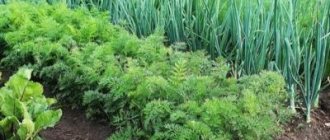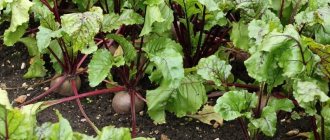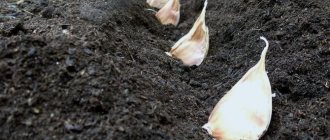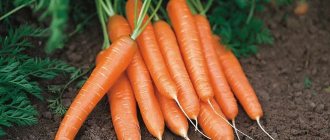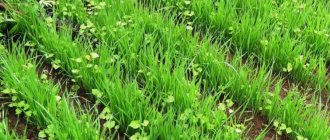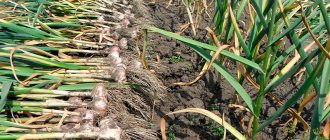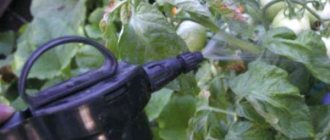One of the greatest achievements of agriculture is the rotation of different crops on one or more plots of land.
Or in short – crop rotation. It is this agrotechnical technique that allows you to regularly harvest increased yields, prevent plant degeneration and increase the fertility of the land. Dear readers!
For you, we have created communities on social networks in which useful articles and interesting ideas are published several times a day! Subscribe and receive useful content in a convenient format! Today we will talk about the principles of crop rotation, proximity in garden beds, and, in addition, how to implement this agricultural method on your own plot of land.
What is crop rotation and why is it needed?
Crop rotation is a regular change of crops growing in the same place in the garden. Moreover, such rotation is carried out according to clearly defined principles.
The fact is that by constantly growing plants in the same places in your garden, you deplete the soil. During the winter, it does not have time to make up for the resulting deficiency of certain microelements. For example, root vegetables need more phosphorus to form than other vegetables. Therefore, if you grow only root crops in the garden beds, a phosphorus deficiency will occur.
To prevent this from happening, use crop rotation.
Interestingly, the longer you avoid planting in old beds, the better. Complex, well-thought-out schemes for several fields are drawn up for ten years. Simpler - for several years, usually 3, less often 4 years.
But even using the simplest scheme, alternating families or groups of crops, you will see a difference in the increase in the number of vegetables obtained and their taste.
IMPORTANT! Growing representatives of the same family in a permanent place increases the concentration of pathogenic microelements in the soil.
Good and bad neighborhoods
Good compatibility of crops for joint planting
Many years of experience in cultivating garden crops allows us to compile a list of plants that have a beneficial effect on each other:
- Beans, cabbage, corn, eggplants, spinach, carrots, radishes, lettuce and dill, planted next to potatoes, help protect them from fungal diseases (late blight), more rational use of moisture and nutrients from the soil;
- Garlic goes well with strawberries and carrots. It protects these crops from pests, and itself is enriched with nutrients;
- You need to add dill and corn plants to the beds with cucumbers; large doses of microelements will be supplied to the soil;
- Peas are a welcome neighbor for tomatoes, eggplants and potatoes; they enrich the soil with nitrogen and improve the soil structure;
- Flowers of Marigold, Carnation, Chamomile protect vegetable crops from pest invasion.
Watch the video! Vegetable neighbors in the garden beds
Poor compatibility of crops for joint planting
The peculiarity of growing plants in summer cottages is that a wide range of crops, both trees and shrubs and vegetables, have to be accommodated in a relatively small area. The fact is that many fruit and nut trees can have a negative effect on plants that are in close proximity to them. Here are examples of negative proximity:
- Walnut inhibits any plants that come into contact with the substance it secretes - juglone;
- Fennel oppresses all crops in close proximity;
- Legumes and wormwood do not get along well;
- Potatoes, cucumbers, tomatoes and strawberries grow worse if they are in the zone of influence of each other's roots, this also applies to all representatives of the Solanaceae family;
- Cabbage and strawberries are two crops that attract a huge number of pests to the site, which negatively affects the growth of each crop individually.
Thus, time spent on designing crop rotations at the dacha is not wasted. A competent approach and thoughtful decisions will allow you to correctly design your dacha crop rotation, save on fertilizers and plant protection products, and get a significant harvest of vegetables.
Watch the video! Crop rotation of vegetable crops
What is joint planting and what crops are compatible?
In addition to crop rotation, a method such as joint planting helps to collect increased yields and protect plantings from pathogenic microflora.
The idea is as follows. Some crops planted nearby have a beneficial effect on their neighbors, driving away parasites and preventing the spread of fungal, bacterial and viral diseases.
Let's look at the most striking examples. Almost everyone knows that onions should be planted next to carrots. These plants drive away parasites from each other.
- Or, for example, basil, which improves the taste of tomatoes growing next to it.
- Garlic and onions grow well next to strawberries and strawberries. They also like the proximity to root vegetables and tomatoes.
- Strawberries , in turn, get along well with nightshades and peas. Feels comfortable next to lettuce and corn.
- Carrots can be sown next to nightshade plantings, including potatoes. It is good to alternate its beds with salad greens and radishes. The same can be said about beets.
- Tomatoes, peppers and eggplants love to grow next to herbs (basil, coriander). They can also be placed near the cabbage.
- If we talk about cucumbers , then it is advisable to sow them close to legumes. This vegetable goes well with sunflower and dill. The last two cultures have a beneficial effect on the taste of cucumbers.
- Potatoes are a rather finicky vegetable, but the beds can be diluted by planting spinach, radishes and beans.
ON A NOTE! When selecting “neighbors”, it is necessary to keep in mind their requirements for lighting, structure and type of soil. And also take into account the similarity of growing seasons.
Vegetable crop compatibility
If you want to place the maximum number of different crops in one garden, you also need to consider their compatibility with other plants. Some “capricious” vegetables do not get along well with their neighbors, while tolerant crops, on the contrary, have a positive effect on their “roommates.”
Thus, carrots and onions are an example of ideal coexistence in the garden. The most dangerous pests of these crops are carrot and onion flies. But the carrot fly cannot tolerate the smell of onions, and the onion fly cannot tolerate the smell of carrots. Therefore, plants from such a tandem perfectly protect each other from insect attacks.
- Mixed plantings: choosing the best neighbors for plants
Let's figure out which plants get along best with common garden crops.
Crop rotation in the garden, table of sowing and planting, predecessors and successors
In the following table we have collected basic information on the compatibility of the main vegetables and which crops need to be rotated when growing in your dacha.
A few words about symbols:
- Vertically, “what we plant,” horizontally, “after which we plant.”
- The “+” sign marks those crops that are good predecessors for each other when grown in the same place.
- The “-” sign marks those plants that are best not to be alternated when grown on the same plot of land.
- Empty graphs indicate that the predecessor has no visible effect on the plant.
| Plant | Garlic | Strawberry | Onion | Carrot | Beet | Tomato | Pepper | Cabbage | Cucumber |
| Garlic | – | – | – | – | + | + | + | + | |
| Strawberry | + | + | + | – | – | + | + | ||
| Onion | – | – | – | – | + | + | |||
| Carrot | + | – | – | + | |||||
| Beet | + | – | – | – | – | – | + | ||
| Tomato | + | – | – | + | + | ||||
| Pepper | + | + | – | – | + | – | |||
| Cabbage | – | + | |||||||
| Cucumber | + | + | – | – | – | – | + | – | |
| Potato | + | + | + | – | – | + | + | ||
| Eggplant | + | + | – | – | + | + |
Good predecessors of vegetable crops
Plants feed on those substances that previous crops did not take from the soil. When planning planting, keep in mind what to plant next in the garden.
| Culture | Predecessor |
| Legumes | All types of cabbage, potatoes, cucumber, zucchini, pumpkin, onions, garlic, eggplant, peppers |
| Cabbage, beets | Cucumber, potato, pepper, carrot, legumes, pumpkin, eggplant |
| Potato | Cabbage, cucumber, pumpkin, onion, garlic, carrots |
| Onion garlic | Cabbage, potatoes, legumes, greens, radishes |
| Carrot | Cucumber, potato, cabbage, tomato, legumes |
| Cucumber, pumpkin, zucchini | Cabbage, legumes, onions, garlic, corn |
| Pepper, eggplant | Cabbage, cucumber, zucchini, pumpkin, onion, garlic, legumes, carrots |
| Tomato | Cucumber, carrots, cabbage, onions, beets |
What to plant next
Now let’s pay a little more attention to what plants need to be selected for planting in place of common garden crops.
What to plant after garlic
Let's start with garlic. In its place it is permissible to plant representatives of the cruciferous family. In addition to them, it is allowed to grow peppers or any other representatives of the nightshade family here.
What can you plant after strawberries?
Once every four years it can be swapped with salad greens. You can also plant cabbage or garlic on the same piece of land one year.
ON A NOTE. It is ideal to grow this berry crop in one place for 4 years and return it back after the same period of time.
What to squeeze after onions
Sow carrots or a representative of the nightshade family (eggplant, tomatoes). Also, after onions, root vegetables such as beets grow well.
Planting crops after carrots
Following this root crop, you can plant potatoes or peppers. It is permissible to sow tomatoes here.
What is better to plant after beets?
Where there used to be beets, plants from the bulbous family take root well. It is permissible to plant tomatoes here.
What to plant after tomatoes
In addition to being wonderful fruits, tomatoes are good because many plants thrive in their place. For example, representatives of pumpkin plants (the same zucchini or zucchini), salad greens, root vegetables. Cabbage grows well in these beds.
What to plant after peppers
Like tomatoes, peppers leave behind well-prepared soil for salad greens, cucumbers, and various root vegetables.
What to plant after cabbage
Here you can plant green manure before winter. In the spring, root vegetables and pumpkin plants will grow quite well in cabbage beds.
Planting after cucumbers
In the usual place of cucumber vines, you can sow sets or garlic in the next summer season. Potatoes will grow well here. Or you can give the land a rest and sow green manure crops.
What to plant after potatoes
Here, salad greens, oats and cabbage grow quite well. You can also sow several cucumber bushes or simply swap these vegetable crops.
ON A NOTE. It is permissible to grow potatoes in old beds for 2 years in a row, subject to mandatory autumn and spring feeding with nutritional compounds.
Sowing planning
Vegetable crop rotation contributes to the accumulation of nutrients in the soil, making it healthier from pathogens and wintering stages of insect pests. Layout and joint cultivation create opportunities for increased yields. Every amateur vegetable grower should have a crop rotation table. It is advisable to remember the principles of fruit change according to various characteristics:
- According to the type of economically valuable part of the harvest, in direct and reverse order, ROOTS are replaced by FRUITS, then LEAF VEGETABLES - FLOWERS;
- Based on belonging to the biological family: plants from the pumpkin, legume, goosefoot and cabbage families are replaced by the nightshade family.
What to plant next
In addition to clear ideas about the sequence, it is important to know a number of rules related to soil fertility and a favorable phytosanitary regime:
- The same crop should not be cultivated in one place for more than one year. Even if the crops are different but belong to the same botanical family, they should not follow each other, since they are damaged by the same pests and react in the same way to soil toxins;
- It is useful to leave the soil fallow, without planting anything for 1-2 years; during the season the area is weeded and loosened, watered if necessary;
- Plants that were grown on the site last year leave behind volumes of root residues, which then rot and create a supply of necessary macro- and microelements in the soil. In addition, bushes with a deep-penetrating root system saturate the soil with oxygen and make it moisture-permeable;
- Tops of vegetable crops and flowers significantly enrich the soil with organic matter, and the site looks clean and tidy;
- Plants that emit substances that repel insect pests can significantly reduce the pesticide load on the soil and the environment;
- The annual cultivation of plants that are highly demanding in terms of mineral nutrition significantly depletes the soil.
Watch the video! What can you plant after - tips for gardeners
Advice! Use the tops of vegetable and flower crops to make compost and create warm beds!
If you follow the above rules, the accumulation of nutrients and soil health will occur in a systematic and targeted manner. Gardeners need to keep a diary where they can record all manipulations in the garden and vegetable garden.
Use of mixed plantings
A number of studies and practical experience of vegetable growers indicate the positive effect of mixed plantings of vegetables. The most suitable planting schemes include:
- onions + carrots;
- radishes + carrots;
- onion + cabbage;
- beets + cabbage.
Seeds are sown in alternating rows, while they help each other to germinate and protect from possible pests. When planning joint plantings of vegetables, it is important to take into account their relationship to light.
There are no shade-loving crops among vegetables. In the complete absence of direct sunlight, they stop developing and produce a crop of poor quality.
Table 1 – Relation of vegetable crops to light level
| Relation of vegetable crops to light level | Culture |
| Photophilous | Tomato, eggplant, pepper, beans, cucumber |
| Moderately light-loving | Onions, legumes, cabbage, carrots, beets, radishes |
| Shade-tolerant | Greens, Chinese cabbage, dill, rhubarb, sorrel, zucchini |
Recommendation! More often combine planting vegetables with garlic, coriander, chamomile, thyme, celery - these plants repel insect pests in the garden and create productive combined crops.
What cannot be planted after: table
In the following table we have collected unsuccessful examples of crop rotation. All information was distributed by culture to make it easier to perceive.
| Culture | Bad Predecessors |
| Basil | Cabbage, carrots |
| Eggplant | Different varieties of peppers and tomatoes |
| Peas | Corn, chickpeas, peas, beans |
| Zucchini | Different varieties of peppers and tomatoes, carrots, cabbage, zucchini, pumpkin |
| Cabbage | Zucchini, pumpkin, root vegetables, cucumbers |
| Potato | Plants from the same family |
| Coriander | Cabbage, carrots |
| Corn | Millet |
| Onion | Salad and spicy herbs, carrots |
| Carrot | Table beet |
| cucumbers | Peppers, cabbage, carrots, zucchini, cucumbers |
| Patissons | Carrots, plants from the same family, eggplant, cabbage, peppers |
| Pepper | Plants from the same family, pumpkin |
| Sunflower | chickpeas, beets, tomatoes, peas |
| Radish | Cabbage, radish, carrots |
| Salad | Cabbage, carrots |
| Beet | Cabbage, potatoes |
| Tomatoes | Plants from the same family |
| Pumpkin | Tomatoes, eggplant, cabbage, carrots |
| Beans | Corn, plants from the same family |
| Garlic | Spicy herbs and salad greens |
| Spinach | Cabbage, carrots |
What is multi-field free circulation
Multi-field crop rotation is similar to regular crop rotation. The entire available area is divided into a certain number of plots. For example, four. Each of them has its own crop. Then the plantings are changed annually.
For example, peas are sown in 1 plot, cabbage in 2 plots, beets in 3 plots, and potatoes in 4 plots. The next year the crops change. Cabbage is planted on 1 plot, beets on 2, potatoes on 3, and peas on 4.
As you can see, the crops are moving from plot 4 to plot 3, and so on.
In a similar way, you can plan crop rotation for several years.
But the method has a drawback. The fact is that the area occupied by different vegetables often varies. For example, most of the dacha plot is always allocated for potatoes. But cabbage or beets are planted in 2-3 beds maximum.
How to practically implement the principle of crop rotation at your dacha
You should start planning already in winter.
Carry out a “categorization” of the vegetable crops that are planned to be planted. The fact is that it is undesirable to seat representatives of one group next to another. Perhaps the tables above do not list all the vegetables that summer residents grow, so it makes sense to list them additionally. Conventionally, all cultures are divided into:
- goosefoot - beets, spinach;
- umbelliferous - parsley, carrots, dill, parsnips, celery, fennel;
- buckwheat – rhubarb, sorrel;
- cruciferous vegetables - horseradish, turnip, cabbage, radish, radish, watercress;
- nightshades - potatoes, eggplants, tomatoes, physalis, peppers;
- legumes – peas, beans, cowpeas, beans;
- lily - garlic, onion, asparagus;
- pumpkin - squash, watermelon, melons, zucchini, cucumbers, pumpkin;
- Compositae - lettuce, artichoke, chicory;
- cereals – sweet corn.
Draw up a diagram of a summer cottage. The entire area is divided into plots, and according to this plan, in accordance with the recommended tables, it is determined which and where the vegetable will be planted. Here are a few more that explain the essence of crop rotation.
What are green manures and how do they affect the soil?
Green manures are green fertilizers. Green manure crops are plants that have a beneficial effect on the structure and composition of the soil. They are grown to restore organic matter and humus, contain useful organic substances, and remove mineral salts.
Also, green manure sown before winter protects the soil from freezing and retains snow on the site, which subsequently leads to saturation of the soil with moisture.
Another useful property of green manure crops is their ability to stimulate the development of beneficial microflora, which suppresses pathogens and prevents the spread of diseases. Plus, green manure kills weeds.
Green manure can be grown simultaneously with the main vegetables, or you can sow them earlier, then mow and incorporate them into the soil as organic fertilizer.
INTERESTING. One of the most popular green manures, mustard, is twice as useful as manure as a fertilizer.
Green manure for soil health
Supporters of organic farming manage to do without mineral fertilizers by correctly alternating plants in the beds. After all, there are plants that enrich the soil with useful substances. First of all, we are talking, of course, about green manure - green fertilizers with a powerful root system and rapidly developing green mass. They are sown between the main crops or in areas empty after harvest, and then mowed and plowed into the ground.
- Green manure: secrets of using green fertilizers
Thanks to green manure plants, you can significantly improve the soil on your site. The main thing is to know how to use them correctly.
- What green manures can be sown in the fall after harvesting?
We'll tell you how to improve the soil by planting green manure plants in the fall.
But there are also plants that can produce crops while also improving the quality of the soil. Such crops include, for example, legumes (peas, beans, etc.). Nodule bacteria on their roots enrich the soil with nitrogen.
If you plan to use legumes as green manure, it is important that they have time to bloom, since nodules on their roots form during this period.
And perennial legumes with a strong root system, including, for example, alfalfa, extract nutrients from the deep layers of the soil and share with vegetables whose roots are located near the surface.
To increase soil fertility, do not leave the beds empty. During the “shift change”, sow the area with green manure: white mustard, phacelia, rapeseed. These crops can also be used to make compost for the plants you plan to plant next season.
- Compost - how to prepare it correctly and quickly
Find out how to properly prepare compost with your own hands and use it effectively in your garden.
Thanks to green manure plants, you can significantly improve the soil and prevent weeds from taking over empty areas.
How to best plan plantings taking into account crop rotation
First of all, make a detailed list of the crops that grow in your garden every year.
Next, determine the number of areas in which you will alternate crops.
The next step is to determine what type of crop rotation you will use. There are 5 methods: by group, by soil requirements, by family, by effect on the soil and by the best predecessor.
We recommend rotating vegetables according to their predecessors. Of course, this method is quite complicated, but it gives you some room to maneuver. This is especially true if most of your garden is occupied by one plant. For example, potatoes. In addition, this method will ensure the most complete crop rotation.
Practical recommendations
- You shouldn't rely on your own memory. It is still possible to retain information about how vegetables were planted last season. And 2 years ago? Experienced summer residents advise keeping a diary, where they can draw planting patterns or arrange it in the form of understandable tables. And also to family members. Things happen in life. Perhaps next year it will turn out that one of the household members will have to do planting vegetables in the dacha.
- When planting perennial vegetables, it is advisable to focus on crops that produce an early harvest. For example, asparagus, sorrel, rhubarb.
- In order not to make mistakes in organizing crop rotation, you can focus on how vegetables grow. In a simplified form, this is expressed as follows: crops that produce “tops” are planted in one season, and “roots” the next year (in the same place).
- If there is a lack of free land, repeated planting should be practiced. But this is a slightly different topic.
The author outlined the essence and all the features of crop rotation. There is nothing complicated about this, as the reader can see. But this applies specifically to a summer cottage, when growing vegetables in open ground. In relation to greenhouses (greenhouses), there are slightly different rules, and this must be taken into account.
Have a good harvest!
What should not be planted nearby?
Another important note about the proximity of cultures. Most related plants grow well together. But there are some exceptions to keep in mind.
It is better not to plant nightshades nearby due to the fact that they are susceptible to the same diseases, and there is a high risk of rapid spread of infection.
A special case is planting sweet and hot peppers next to each other. Cross-pollination occurs and the sweet pepper becomes bitter.
Carrots, parsnips and cucumbers also do not like to live next to their “relatives”. The latter, being grown near zucchini, completely lose their pleasant taste.
Garlic does not grow well next to cabbage. Same as onions. But together, close to each other, they get along quite normally.
Cabbage should be planted with plants such as garden strawberries and representatives of the legume family.
Cucumbers do not welcome proximity to their pumpkin “relatives” and potatoes.
Classification of crops and interaction with soil
Crops grown in a summer cottage consume different substances from the soil. Therefore, it is necessary to constantly change the beds. The plants must be returned to their original place of cultivation after four or six years. To implement crop rotation, it is necessary to take into account their nutritional needs and soil condition.
Plants not only extract nutrients from the soil, but also improve its composition. Buckwheat reduces soil acidity, legumes enrich it with nitrogen. Cabbage and potatoes suppress the growth of weeds. You need to know which family the plants belong to. Crop rotation at a summer cottage takes into account the classes of plants according to the table.
Table 1. Vegetables of botanical families
| View | Vegetables |
| nightshade | tomato, eggplant, potato |
| pumpkin | cucumber, zucchini, pumpkin, lupine, clover |
| legume | peas, beans, soybeans |
| cabbage | cabbage, radish, horseradish, mustard |
| onion | onion garlic |
| umbrella | carrots, parsley, dill |
| amaranthaceae | beets, spinach |
| aster | salad, sunflower |
| green | lettuce, sorrel, watercress |
| buckwheat | buckwheat, sorrel, rhubarb |
Based on their nutrient requirements, plants can be divided into four groups. The following crops require the most fertilized soil: cabbage of all types, zucchini, pumpkin, sunflowers and potatoes. Nitrogen-containing fertilizers are required for their growth. Plants with average nutritional requirements include tomatoes, eggplants, cucumbers, melons, onions and corn.
Phosphorus fertilizers, compost, and ash must be added to the soil. Crops such as carrots, beets, spinach, dill and celery are undemanding, but the soil must be mulched with compost and potassium supplements added. The fourth group includes plants that saturate the soil with nitrogen and loosen it. Legumes: peas and beans. Potatoes and cabbage inhibit the growth of weeds. Cultivation is carried out according to the following principle:
Table 2. Crop rotation in relation to soil
| 1.High demand | 2.Average need |
| 4. Legumes | 3.Weak need |
The cycle is four-year: legumes move to the place of plants that require the maximum amount of nutrients and replace crops with an average need for mineral fertilizers. They move to third place, vegetables with low nutritional requirements take the place of legumes, and legumes take first place. The move occurs annually. This allows plants to have adequate nutrition.
Changing the place of cultivation of vegetables on the site makes it possible to reduce the use of mineral fertilizers and reduce the number of pests and diseases in the soil. Black steam is the best for all plants, as it allows the soil to rest. But summer cottages are mostly small in size, so it is quite difficult to increase soil fertility in this way.
Another way to increase yield is to add nutrients to the soil. The needs of plants are different and are divided into groups:
- Application of manure. Required species: cabbage, pumpkin and potato.
- Phosphorus fertilizers and ash. Improves the growth of root crops.
- Adding humus, peat, sawdust. Used for onions and greens.
- Potash fertilizers and ash. Necessary for root vegetables.
When choosing a place to plant vegetables, it is necessary to take into account the need for lighting. Light-loving plants include nightshade and pumpkin crops. Legumes and root vegetables tolerate partial shade. Shade-loving plants include greens, sorrel and zucchini.
Common mistakes
The most common mistake is incorrectly selected predecessors and successors when sowing or planting incompatible plants nearby..
Also, quite often, summer residents think that when using crop rotation there is no need to apply fertilizers or feed the plants. This is a misconception. Plantings still need regular feeding and watering. Gradually you will reduce the amount of fertilizer applied, but in the first years after the start of crop rotation it is necessary to feed.
Sometimes it happens that the neighbors are chosen well, but the growing seasons or plant care requirements differ. Thus, vegetables must be selected not only according to general abstract compatibility, but also according to the timing of their growing season, as well as their care requirements.
Answers to frequently asked questions
Is it possible to organize crop rotation on 6 acres?
Crop rotation can be done in any size garden. It is only important to correctly plan the sequence of growing crops.
Is this even necessary?
It's up to you to decide. But keep in mind that the land is gradually losing its fertile properties. Growing different plants in the same area will restore soil fertility.
So what can you plant next to tomatoes?
The best neighbor is basil, which will improve the taste of the fruit.
It turns out that potatoes cannot be planted in one place? How then?
It is possible, but it is necessary to apply fertilizers to replenish soil resources. But after a couple of years, it’s still better to change the place where you plant potatoes in your summer cottage.
Compatibility of vegetables in the garden in case of mixed plantings
Growing different agricultural crops together on one piece of land has a special meaning. Vegetables interspersed with spicy salad herbs and annuals such as calendula and cloves fall under their protection. Pests hate flowers from the clove family and nasturtiums, and gardeners willingly use them as seasonings for autumn preparations and summer gourmet salads.
The compatibility of vegetables and other cultivated plants can be used as an effective means of pest protection. A pre-prepared diagram will significantly save time later. Below are several examples of favorable placement of different plants on one piece of land.
Successful neighbors on the same bed
- Kohlrabi cabbage, fragrant coriander and decorative horned violet (Pansy). The role of the protector here is played mainly by those same tricolor flowers that often decorate embroidery. Slugs really don’t like this plant, while they can’t miss a single kohlrabi bush. Therefore, “Pansy” is the best guardian for cabbage.
- Leeks and celery make a wonderful tandem in one place in the garden. The onion, in a completely neighborly manner, sensitively and selflessly protects the celery roots from rust fungus. And he, in turn, spreading a strong aroma, drives the onion fly and onion moth away from the garden bed.
- Marigolds and kale are not only compatible, but also aesthetically pleasing. The proximity of orange spicy flowers will allow the gardener to tear off the outer leaves from heads of cabbage for salads and not be afraid that the plant will die due to an invasion of whiteflies. Thus, you can eat fresh cabbage from mid-summer until autumn.
- Tomatoes grow better next to calendula. This medicinal plant is a natural enemy of brown nematodes, which live in the soil and are very fond of tomato fruits.
- In principle, peas have a good effect on any neighbor, but red cabbage gets along especially well with them. She also favors spinach.
Based on the data provided, you can make a schedule of what to plant in the garden and what plants to place in the neighborhood. To increase the number of fruits and significantly save space on the site, compact sowing technology is used. This means that in the same garden bed, different garden food crops are grown during the season, planted one after another. During a standard summer, you can harvest three harvests of different early-ripening vegetables. Knowledge is power, and knowledge of the crop rotation table for vegetables in the beds is also the rational use of natural resources.
Did the article help? Rate it
